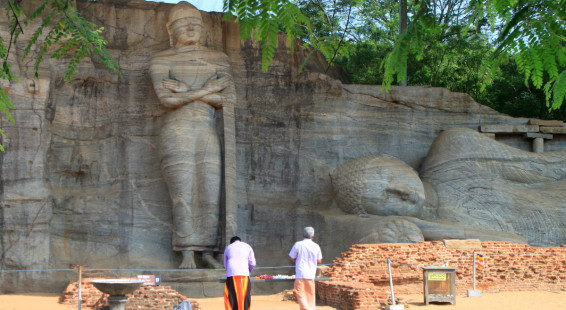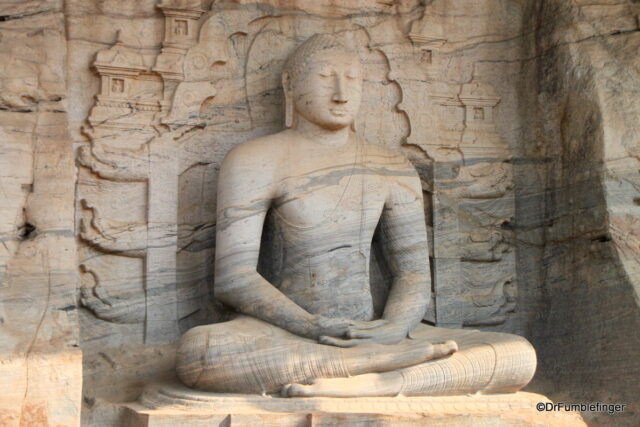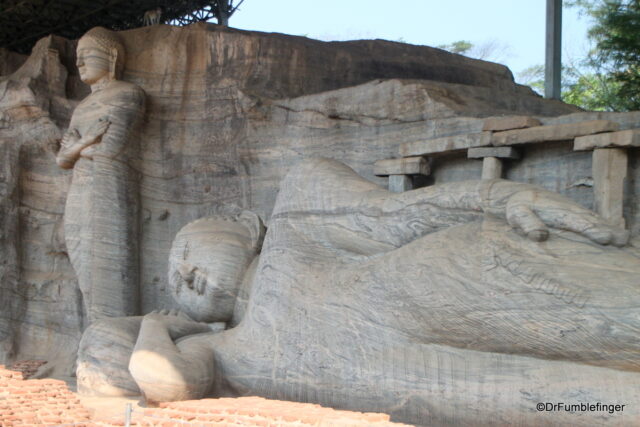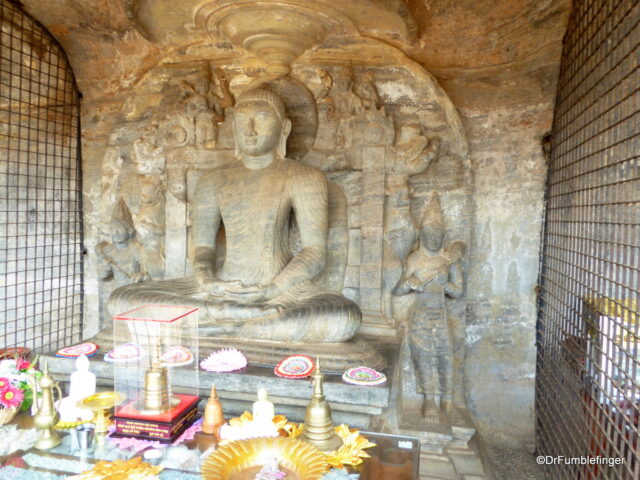
One of the most amazing sites in Sri Lanka is the Gal Vihara, which is located within the ancient city of Polonnaruwa, a UNESCO World Heritage Site. I thought the Gal Vihara was unusual and interesting enough to warrant a more detailed blog. During my last visit I spent a full hour here, studying and photographing details of the carvings and just watching people.
This has long been a site of Buddhist worship and teaching. Gal Vihara (meaning ‘Rock Temple’) is an amazing collection of beautifully sculpted Buddha images carved from a massive granite boulder. The scope of the carvings and their beautiful detail never cease to amaze me. Hard to imagine the time it took to craft such works with only a hammer and chisel. The rock has been cut back almost 15 feet (4.6 m) deep to create a suitable place which accommodates the Buddha images. The size of each carving appears limited by the height and lay of the rock formation, which they are still part of.
Gal Vihara was commissioned by King Parakramabahu I (1153 – 1186 A.D), who also built Polonnaruwa’s Great Palace Complex and the Vatadage (where the sacred Buddha Tooth Relic was kept). Each statue when completed likely was within its own own decorated image house, as indicated by the remains of brick walls, but these structures have been lost. I actually find it more impressive to see the grouping as one unit, rather than in small individual buildings.
Gal Vihara is one of the most sacred Buddhist shrines in Sri Lanka and you’ll see pilgrims approach it with reverence, leaving offerings of flowers, and praying. There are four Buddha sculptures, in four different poses. They are each considered to be in a “cave”, though to they are not caves in the sense of the type you find in Dambulla.
The following are the four Buddha images you find at Gal Vihara:
1) Sitting Image (Meditative Attitude)

Gal Vihara, Samadhi statue
It’s believed this carving was once painted in gold, but if so the gold was looted long ago. It’s 4.6 m (15 feet) tall and depicts the Dhyana mudra position. The seat is carved in the shape of a lotus blossom, and its based has intricate carvings of lions and flowers.
2) Standing Image

Gal Vihara, Standing statu
A seven meter (almost 23 feet) tall stone sculpture, the second largest of this group. It stands on a pedestal shaped like a lotus blossom. There was some debate whether this was actually the statue of Buddha, or of a monk named Ānanda, although the thinking today is that it is a Buddha image.
3) Reclining (or Sleeping) Image (parinirva — nirvana after death)

Gal Vihara, Recumbant Image
The largest and to me most impressive of the group. The carving is 14 meters (46 ft) long and beautifully detailed. For example, where the Buddha’s head rests on the pillow, you can see its indentation. It is the image of the dying Buddha.
4) Vijjadhara Guha (Cave of the Spirits of Knowledge)

Vijjadhara Guha
The only image situated in a true cave, and a man-made one at that, the fourth image is the smallest of the group at just over 4.5 feet (1.4 m). Lions and lotuses are also used in the decoration. A halo is carved behind the head of the statue, which rests between two four-armed deities. The walls of the cave were once decorated with frescoes, traces of which can still be found if you look closely.
Situated near this cave is a rock tablet carved with the code of conduct for Buddhist monks, known as Uttarama. Apparently one of King Parakramabahu greatest achievements was in unifying the different factions of Buddhist monks.
If You Visit
The Gal Vihara is located inside the ancient city of Polonnurawa, which will cost USD 25 to enter. The temple is open from 7.30 am to 6.00 pm. As it is a religious site, it is important to dress modestly, covering your arms and legs, and be quiet and respectful. It is hot here, so bring lots of water.
The Gal Vihara is most highly recommended and one of the top historic sites in the country.
(Click on thumbnails to enlarge, right arrow to advance slideshow)